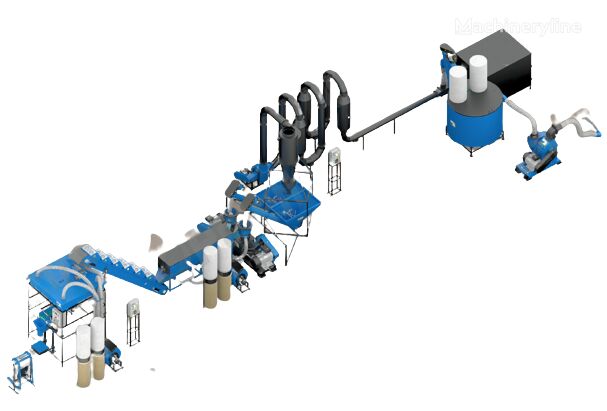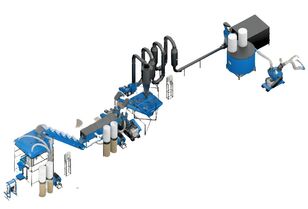Presse à agglomérer Peletto PELETON 3000 DUO MT | 65,5 kW | 700 kg/h neuve







Si vous décidez d'acheter un véhicule ou du matériel à bas prix, assurez-vous que vous communiquez avec un vendeur réel. Cherchez autant d'informations sur le propriétaire que possible. Un escroc peut se faire passer pour une société réelle. En cas de doute, contactez-nous en utilisant le formulaire de commentaires afin que nous effectuions un contrôle supplémentaire.
Avant d'effectuer un achat, étudiez attentivement plusieurs offres de vente afin de connaître le coût moyen du modèle de véhicule ou d'équipement que vous avez choisi. Si le prix de l'offre qui vous intéresse est très inférieur aux offres similaires, réfléchissez bien. Une différence de prix considérable peut indiquer la présence de défauts cachés ou une tentative d'escroquerie.
N'achetez pas de produits dont le prix est trop différent du prix moyen de produits similaires.
Ne consentez pas à payer une caution ou une avance douteuse. En cas de doute, n’hésitez pas à demander des précisions, des photos et des documents supplémentaires, vérifier l'authenticité des documents ou encore poser des questions.
C'est l'arnaque la plus répandue. Des vendeurs malhonnêtes peuvent demander une avance sur le montant total pour « réserver » votre achat. De cette manière, ils peuvent recueillir un montant considérable, puis disparaître.
- Faire un prépaiement sur la carte
- N'effectuez pas de prépaiement sans établir de documents confirmant le transfert d'argent si le vendeur vous semble suspect au cours de vos échanges.
- Transfert de l'argent sur le compte séquestre
- Méfiez-vous de ce genre de demandes, il est très probable que vous soyez en train de communiquer avec un fraudeur.
- Virement sur le compte d'une société avec un nom similaire
- Soyez vigilant(e), des fraudeurs peuvent se faire passer pour des entreprises connues en introduisant des modifications mineures dans le nom. Ne transférez pas d'argent en cas de doute sur le nom de l'entreprise.
- Substitution de ses propres coordonnées dans la facture d'une entreprise réelle
- Avant d'effectuer le virement, vérifiez que les coordonnées indiquées sont exactes et qu'elles appartiennent à l'entreprise indiquée.
Coordonnées du vendeur


 Pologne
Pologne 










































Die komplette Linie PELETON 3000 DUO MT enthält:
Pelletproduktionslinie LDG-3000 DUO
Aerodynamischen Trockner SA-800
Halbautomatisches Kühl- und Verpackungssystem LH-1000
Der Produktionszyklus einer Maschine zur Herstellung von Pellets aus nassem Sägemehl besteht aus mehreren Phasen:
Phase der Rohstoffvorbereitung. Zunächst wird das Rohmaterial aufbereitet und auf die entsprechende Fraktion zerkleinert. Der ideale Anteil gilt als 1 mm kleiner als der Durchmesser der Löcher in der Matrize. Das zerkleinerte Rohmaterial wird weiter zum SA-800-Trockner transportiert, wo die Produktfeuchtigkeit auf den idealen Wert, d. h. 12–15 %, gebracht wird. Am Ende des Trockners befindet sich ein Zyklon, der heiße Luft und Dampf vom getrockneten Rohmaterial trennt.
Phase der Pelletierung des Rohmaterials. Vom Zyklon gelangt das getrocknete Rohmaterial zum Schneckenförderer. Speziell für die Linie mit dem DUO-Index wurde ein Feeder mit vergrößertem Trichter und zwei Schnecken entwickelt. Die Vorschubgeschwindigkeit des Rohmaterials wird für jede Schnecke separat über ein Potentiometer gesteuert. Von der Zuführung gelangt das Produkt zu zwei PELETON-300-Pelletmaschinen. Unsere Sägemehl-Pelletmühle ist auch für die Verarbeitung harter Rohstoffe wie Sägemehl von Laubbäumen oder Kokosnussrinde konzipiert.
Siebphase. Der nächste Produktionsschritt einer kompletten Produktionslinie für nasse Sägemehlpellets ist das Sieben des Produkts. Von der Pelletmühle gelangen die Pellets zur Kalibriertrommel, wo sie durch Luftzirkulation gekühlt werden. Durch die Absaugung werden Staub und nicht pelletierte Partikel in Staubsammelbeutel überführt. Staub aus den Beuteln kann im Pelletierungsprozess wiederverwendet werden.
Kühl- und Verpackungsphase. Der letzte Schritt besteht darin, die Pellets auf eine Temperatur abzukühlen, bei der die Beutel versiegelt werden können. Dabei hilft der Komplex aus Kühlung und Pelletverpackung. Ein Förderband mit Ventilatoren und einem geschlossenen Puffer der Wiegemaschine mit angeschlossener Absauganlage kühlt die Pellets durch Luftzirkulation und Einblasen auf eine verpackungsfähige Temperatur ab. Die halbautomatische Wiege- und Verpackungsmaschine ermöglicht eine schnelle und genaue Beladung mit fertigen Pellets.
Durchmesser der Arbeitslöcher in der Matrize von 2 bis 8 mm (die Matrize wird an die Bedürfnisse des Kunden angepasst)
Spannung 400V
Gesamtmotorleistung 65,5 kW
Garantiezeit 12 Monate
Europäisches Produkt direkt vom Hersteller, Garantie, Ersatzteile verfügbar. Nettokaufpreis mit USt.Id.Nummer (innergemeinschaftlicher Erwerb).
Selbstabholung oder Lieferung nach Vereinbarung. Es besteht die Möglichkeit, die Maschine vor dem Kauf zu besichtigen und zu testen.
Ich freue mich auf Ihre Anfragen. Wir helfen Ihnen gerne bei der Auswahl der richtigen Ausrüstung für Ihre Bedürfnisse.
The complete PELETON 3000 DUO MT line includes:
Pellet production line LDG-3000 DUO
Aerodynamic dryer SA-800
Semi-automatic cooling and packaging system LH-1000
The production cycle of a machine for the production of pellets from wet sawdust consists of several stages:
Raw material preparation stage. First, the raw material is prepared and crushed to the appropriate fraction. The ideal fraction is considered to be 1 mm smaller than the diameter of the holes in the die. The crushed raw material is further transported to the SA-800 dryer, where the product moisture is adjusted to the ideal value, i.e. i.e. 12-15%. At the end of the dryer there is a cyclone that separates hot air and steam from the dried raw material.
Pelletizing phase of the raw material. From the cyclone the dried raw material goes to the screw conveyor. A feeder with an enlarged hopper and two screws was specially developed for the line with the DUO index. The feed speed of the raw material is controlled separately for each screw by a potentiometer. From the feeder the product goes to two PELETON-300 pellet machines. Our sawdust pellet mill is also designed for processing hard raw materials such as sawdust from deciduous trees or coconut bark.
Sieving phase. The next production step of a complete wet sawdust pellet production line is sieving the product. From the pellet mill the pellets go to the calibration drum where they are cooled by air circulation. The suction transfers dust and non-pelletized particles into dust collection bags. Dust from the bags can be reused in the pelletizing process.
Cooling and packaging phase. The final step is to cool the pellets to a temperature at which the bags can be sealed. The complex of cooling and pellet packaging helps with this. A conveyor belt with fans and a closed buffer of the weighing machine with a connected extraction system cools the pellets to a temperature suitable for packaging by air circulation and blowing. The semi-automatic weighing and packaging machine enables quick and accurate loading with finished pellets.
Diameter of the working holes in the die from 2 to 8 mm (the die is adjusted to the customer's needs)
Voltage 400V
Total motor power 65.5 kW
Warranty period 12 months
European product directly from the manufacturer, warranty, spare parts available. Net purchase price with VAT number (intra-community acquisition).
Self-collection or delivery by arrangement. There is the possibility to view and test the machine before purchasing.
I look forward to your inquiries. We will be happy to help you choose the right equipment for your needs.
Co wchodzi w skład kompletnej linii do peletu z mokrej trociny PELETON 3000 DUO MT?
Linia do produkcji pelletu LDG-3000 DUO
Suszarnia aerodynamiczna SA-800
Półautomatyczny system chłodzenia i pakowania LH-1000
Cykl produkcyjny maszyny do produkcji peletu z mokrej trociny składa się z kilku etapów
Etap przygotowania surowca. Najpierw surowiec jest przygotowywany i rozdrabniany do wielkości odpowiedniej frakcji. Idealna frakcja jest uważana o 1 mm mniejsza niż średnica otworów w matrycy. Mokry rozdrobniony surowiec jest dalej transportowany do suszarni SA-800 gdzie wilgotność produktu doprowadzana jest do idealnej czyli 12-15%. Na końcu suszarni znajduje się cyklon, który oddziela gorące powietrze razem z parą od wysuszonego surowca.
Etap peletowania surowca. Z cyklonu wysuszony surowiec trafia do podajnika ślimakowego. Specjalnie dla linii z indeksem DUO zaprojektowano podajnik z powiększonym zasobnikiem oraz 2 żmijki. Prędkość podawania surowca jest sterowana oddzielnie dla każdej żmijki za pomocą potencjometru. Z podajnika produkt trafia do dwóch peleciarek PELETON-300. Peleciarka do trocin naszej produkcji jest zaprojektowana do przerabiania twardych surowców takich jak trociny z drzew liściastych czy kora kokosowa.
Etap przesiewania. Kolejnym etapem produkcyjnym kompletnej linii do produkcji peletu z mokrej trociny jest przesianie produktu. Z peleciarki pelet trafia do bębna kalibrującego, gdzie za pomocą cyrkulacji powietrza jest schładzany. Za pomocą odciągu pył oraz niespeletowane cząstki trafiają do worków odpylających. Pył z worków może być wykorzystywany ponownie w procesie peletowania.
Etap chłodzenia oraz pakowania. Finalnym etapem jest schładzanie peletu do temperatury, przy której worki mogą zostać zgrzane. Pomaga w tym kompleks chłodzenia oraz pakowania peletu. Taśmociąg z wentylatorami oraz zamknięty bufor wagopakowarki z podłączonym systemem odciągów, za pomocą cyrkulacji oraz nawiewu powietrza schładza pelet do temperatury pozwalającej na jego pakowanie. Półautomatyczna wagopakowarka pozwala na szybki oraz dokładny załadunek gotowego peletu.
Średnica roboczych otworów w matrycy od 2 do 8 mm (matryca jest dostosowana do potrzeb klienta)
Napięcie 400 V
Łączna moc silników 65,5 kW
Okres gwarancji 12 miesięcy
Zapraszam do kontaktu w celu dobrania najbardziej optymalnej linii